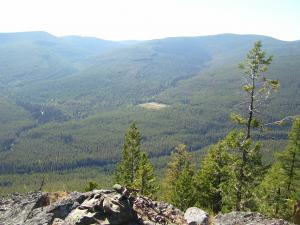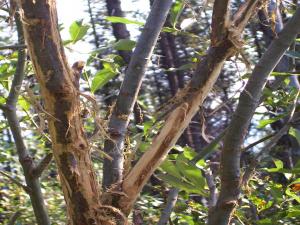How To Scout For an Elk Hunt
The hunting season begins with periods specified for hunting with primitive weapons. Archery is usually the first to be allowed and begins in late August or early September, depending on the State and Province of the hunt.  For elk scouting, this is when older bulls have already started to shed their velvet and have been making rubs and wallows. They can be heard bugling in the high country. Bulls can be in bachelor herds found in high alpine meadows.
For elk scouting, this is when older bulls have already started to shed their velvet and have been making rubs and wallows. They can be heard bugling in the high country. Bulls can be in bachelor herds found in high alpine meadows.
A view of the clear cut I started hiking from in order to get to this alpine area where I spotted a herd of bachelor bulls.
It is important not to disturb the elk during scouting, even on private land. Driving must stop quite some distance away form the place where elk are expected to be present. However, not finding elk sign in the area, does not necessarily mean that there are no elk around. A large home range for elk can be around thirty-five to forty square miles. Due to the vastness of the range, elk do not leave their signs everywhere in their range, and there remains a possibility that the same area may see some elk presence the very next day, or week.
When scouting elk you need to watch out for signs of their presence and must know how to interpret them. Some probable places to look for signs would be along trails, areas under heavy foliage cover (these are likely bedding grounds) and waterholes. If elk have used the area, you will find tracks and droppings to indicate their visit. Tracks can give you an idea of the sex and size of the animal. Bull elk tracks present a somewhat square outline as compared to the cow elk or domestic cattle. Mature bull elk tracks are about four to four and a half inches long, not accounting for the dewclaws. Elk droppings are more oblong and larger than deer droppings, with bull pellets indented at one end and pointed at the other. Cow elk pellets are usually pointed at both ends. If elk have been foraging on succulent moist grasses, their droppings tend to have a clumped small cow pie like appearance.
Elk frequently bed in open meadows during the night. In the daytime, they prefer bedding in heavily covered placed in close proximity of water holes. Look for scrapes in such places while scouting to locate bedding areas. Scout around for wallows near springs or streams and low lying areas. Wallows are places where bull elk urinate in the mud and roll around to cover themselves with it. The urine soaked mud bestows them with a strong smell that the cow elk find extremely appealing and the bull uses this to pull them into his harem.
 Elk rubs can be found on spruce, pine or aspen trees. Rubs are places where the bulls rub their antlers to rid them of the velvet stripping the bark, at waist or shoulder height. Places where bulls thrash the trees are marked by broken off outer branches of spruce and brush. In aspen groves, you may find elk tooth scars. These are parallel gouges on the tree caused by the bull biting the tree with his incisor teeth. All these signs suggest that the area has been used by elk in the past and may be used again. You must also make use of a game-scouting camera during your elk scouting.
Elk rubs can be found on spruce, pine or aspen trees. Rubs are places where the bulls rub their antlers to rid them of the velvet stripping the bark, at waist or shoulder height. Places where bulls thrash the trees are marked by broken off outer branches of spruce and brush. In aspen groves, you may find elk tooth scars. These are parallel gouges on the tree caused by the bull biting the tree with his incisor teeth. All these signs suggest that the area has been used by elk in the past and may be used again. You must also make use of a game-scouting camera during your elk scouting.
I found this elk rub along a logging road at a high elevation in early september.
Scouting before your hunt can lead to a much more enjoyable hunting experience and will greatly increase your chances of success.

